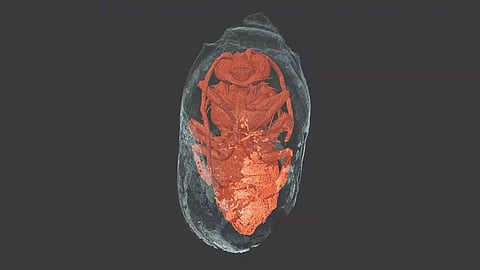

SARAH DEROUIN
A research team was combing the coastline of southwest Portugal in 2019 in search of signs of how its ecosystem had changed over time. They stum- bled upon an astonishing and unexpected scene: bees that had been mummified in subterranean sarcophagi for nearly 3,000 years. An unlikely series of events had conspired to preserve this helpless horde of pollinators over millenniums. Whatever had happened, it was “an unlucky night for hundreds of adult bees that were ready to leave their cocoons,” said Carlos Neto de Carvalho, a paleontologist and scientific coordinator at the Naturtejo UNESCO Global Geopark in Portugal.
Global Geopark in Portugal. These were not typical European honey- bees in a hive, but members of a group called Eucera. The bees spend most of their yearlong lives gestating underground and eating pollen left by their mothers, emerging for only a few weeks when their favorite flowering plant blooms.
Considering the clues, Neto de Carvalho and his colleagues deduced that the bees had most likely met an abrupt demise. “Hundreds of bees pre- served in their brood nests just before exiting means that something catastrophic happened for them in what is now the sunny coast of Portugal,” he said.
The team described its discovery last month in the journal Papers in Palaeontology, and offered a hypothesis for what killed the trapped bees. Bees have evolutionary staying power, and their ancestors are known to have lived on Earth over the course of 120 million years. They have withstood wild climate swings and thrived wherever a flowering plant might have rooted.
But finding actual fossilised bee bodies — unlike turtle bones preserved in sediment layers — is rare. “The exoskeleton of bees (and insects in general) is made of chitin, a cellulose-like biopolymer that quickly is decomposed after the animal dies,” Neto de Carvalho wrote in an email. What bees typically leave are trace fossils or ichnofossils — imprints frozen in time of bodies, abandoned or active nests, or old burrows.
The cocoons that the team discovered were lined and sealed with a silk-like thread produced by the mother bee. This thread was a waterproof, organic polymer — a mixture of material and structural engineering — that had fostered the preservation of the bees inside. Neto de Carvalho said that this “organic mortar” had protected the cells from the environment, shielding the delicate chitin from bacterial activity and decomposition.
Sealed in their cocoons, the bees mummified, preserving their body shape and distinctive features. The team used X-ray microcomputed tomography — a type of CT scanning that captures detailed images of small things like insects — to examine the mummified bees without destroying the protective cocoons. “I think what makes this study so cool is that you do have the bee in there and you can see that it’s in the tribe Eucerini, which are the long- horned bees,” said Bryan Danforth, an entomologist at Cornell University who was not involved in the study. “If you look at the CT image, you can see the long antennae, so you know it’s a male.”